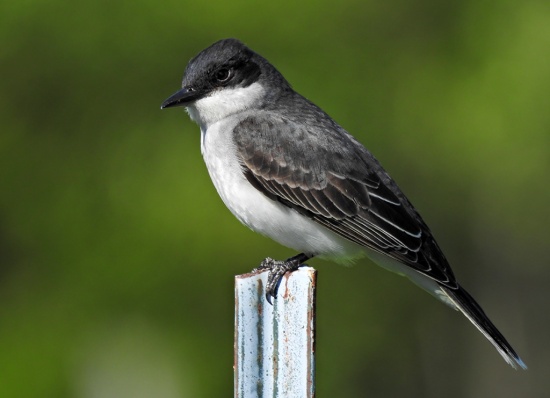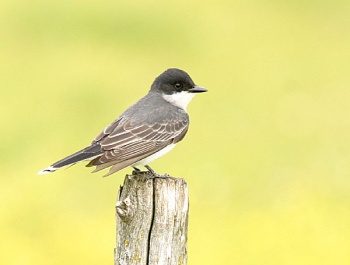(update link) |
(Change pictures to landscape orientation. Flight picture. Imp sizes. Some extra info. References updated) |
||
| Line 1: | Line 1: | ||
| − | [[Image: | + | [[Image:DSCN33301.jpg|thumb|550px|right|Photo by {{user|Aandeg|Aandeg}}<br />Western [[New York]], May 2015]] |
;[[:Category:Tyrannus|Tyrannus]] tyrannus | ;[[:Category:Tyrannus|Tyrannus]] tyrannus | ||
==Identification== | ==Identification== | ||
| + | 19–23 cm (7½-9 in) | ||
*Charcoal gray upperparts | *Charcoal gray upperparts | ||
*Black cap | *Black cap | ||
| Line 7: | Line 8: | ||
*WWhite tip on tail | *WWhite tip on tail | ||
==Distribution== | ==Distribution== | ||
| + | [[Image:2288IMG 3961eaki.jpg|thumb|350px|right|Juvenile<br />Photo by {{user|Kent|Kent}}<br />[[Minnesota]], [[USA]], June 2004]] | ||
This species breeds throughout much of the [[USA]] and [[Canada]]; absent only in [[Alaska]], [[Yukon Territory]], [[California]] most of [[Nevada]], southern [[Utah]], [[Arizona]], southern [[New Mexico]], and western [[Texas]]. | This species breeds throughout much of the [[USA]] and [[Canada]]; absent only in [[Alaska]], [[Yukon Territory]], [[California]] most of [[Nevada]], southern [[Utah]], [[Arizona]], southern [[New Mexico]], and western [[Texas]]. | ||
| Line 14: | Line 16: | ||
==Taxonomy== | ==Taxonomy== | ||
This is a [[Dictionary_M-O#M|monotypic]] species<sup>[[#References|[1]]]</sup>. | This is a [[Dictionary_M-O#M|monotypic]] species<sup>[[#References|[1]]]</sup>. | ||
| − | |||
==Habitat== | ==Habitat== | ||
| − | + | A variety of open areas with a few tall trees or powerlines and forests, including gallery forest, clearings and forest borders. | |
==Behaviour== | ==Behaviour== | ||
| − | [[Image: | + | [[Image:IMG 35232.JPG|thumb|350px|right|Photo by {{user|tetoneon|tetoneon}}<br />[[New Jersey]], [[USA]], May 2015]] |
Often flies into the air from a perch to catch an insect (flycatching). | Often flies into the air from a perch to catch an insect (flycatching). | ||
| + | ====Diet==== | ||
| + | Their diet consists mostly of flying insects, particularly in the breeding season. They will also sometimes take small frogs. Fruit forms a large part of their diet too. | ||
==References== | ==References== | ||
| − | #{{Ref- | + | #{{Ref-Clements6thAug15}}#Handbook of the Birds of the World Alive (retrieved January 2016) |
{{ref}} | {{ref}} | ||
==External Links== | ==External Links== | ||
| − | {{GSearch|Tyrannus_tyrannus}} | + | {{GSearch|Tyrannus_tyrannus}} |
<br /> | <br /> | ||
{{Video|Eastern_Kingbird}} | {{Video|Eastern_Kingbird}} | ||
[[Category:Birds]] [[Category:Tyrannus]] [[Category:Videos]] | [[Category:Birds]] [[Category:Tyrannus]] [[Category:Videos]] | ||
Revision as of 00:04, 9 January 2016
- Tyrannus tyrannus
Identification
19–23 cm (7½-9 in)
- Charcoal gray upperparts
- Black cap
- White throat and belly, some gray smudges on chest
- WWhite tip on tail
Distribution
This species breeds throughout much of the USA and Canada; absent only in Alaska, Yukon Territory, California most of Nevada, southern Utah, Arizona, southern New Mexico, and western Texas.
Winters in South America.
Rare vagrant in California, Arizona, Newfoundland, and Alaska.
Taxonomy
This is a monotypic species[1].
Habitat
A variety of open areas with a few tall trees or powerlines and forests, including gallery forest, clearings and forest borders.
Behaviour
Often flies into the air from a perch to catch an insect (flycatching).
Diet
Their diet consists mostly of flying insects, particularly in the breeding season. They will also sometimes take small frogs. Fruit forms a large part of their diet too.
References
- Clements, J. F., T. S. Schulenberg, M. J. Iliff, D. Roberson, T. A. Fredericks, B. L. Sullivan, and C. L. Wood. 2015. The eBird/Clements checklist of birds of the world: v2015, with updates to August 2015. Downloaded from http://www.birds.cornell.edu/clementschecklist/download/
- Handbook of the Birds of the World Alive (retrieved January 2016)
Recommended Citation
- BirdForum Opus contributors. (2024) Eastern Kingbird. In: BirdForum, the forum for wild birds and birding. Retrieved 20 April 2024 from https://www.birdforum.net/opus/Eastern_Kingbird
External Links






